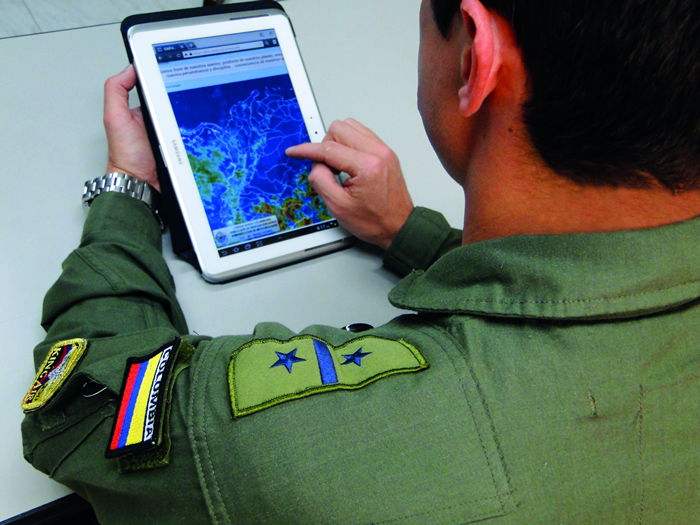Remote Analysis and Monitoring of Environmental Variables on Indoor Environment by Means of a Mobile Device with Android
DOI:
https://doi.org/10.18667/cienciaypoderaereo.426Keywords:
Automation, Centralized Architecture, Control System, Home AutomationAbstract
The implementation of automation techniques in the development of activities in everyday life, has enabled the development of systems aimed at improving comfort inside structures inhabited by people, allowing the study of environmental variables such as temperature, humidity and light intensity systems. Automation is among the topics with higher interest of research, it integrates the need to provide security, energy management and well being on it. In this article, the results of the analysis and remote control of environmental variables inside a prototype of an apartment are exposed. The results were aimed at improving the conditions of hosting and security in everyday environments of the urban population and thus perform remote monitoring via a mobile device with Android operating system.Downloads
References
Aarts, J., y Heitkamp, F. (2011). Small Scale Living (SSL) for the elderly through House Automation (domotica). En FITCE Congress (FITCE), 50th, 1-3.
https://doi.org/10.1109/FITCE.2011.6133430
Aragues A., Martínez, I., Del Valle, P., Munoz, P., Escayola J., y Trigo, J. D. (2012). Trends in entertainment, home automation and e-health: Toward cross-domain integration, IEEE Commun. Mag.,50 (6), 160-167.
https://doi.org/10.1109/MCOM.2012.6211501
Barbieri, T., Bianchi, A., Fraternali, P. y Tacchella, C. (2010). Autonomamente project - design, implementation and evaluation of a multimodal domotic application to support persons with cognitive disabilities. En 12th IEEE International Conference on e-Health Networking Applications and Services (Healthcom), 1-6.
https://doi.org/10.1109/HEALTH.2010.5556591
Bonino, F. C. D. (2010). DogSim: A state chart simulator for Domotic Environments, 208 - 213.
https://doi.org/10.1109/PERCOMW.2010.5470666
Buoro, D. Casisi, M. Pinamonti, P. y Reini, M. (2012). Optimal synthesis and operation of advanced energy supply systems for standard and domotic home, Energy Convers. Manag., 60, 96-105.
https://doi.org/10.1016/j.enconman.2012.02.008
Bonino, D. y Corno, F. (2011). Modeling, simulation and emulation of Intelligent Domotic Environments. Autom. Constr., 20 (7), 967-981.
https://doi.org/10.1016/j.autcon.2011.03.014
Das, R., Dutta S., Samanta, K., Sarkar, A., y Das, D. (2013). Security based Domotics. Procedia Technol.,10, 942-948.
https://doi.org/10.1016/j.protcy.2013.12.441
Dobrescu, L. (2014). Domotic Embedded System, ArXiv14124406 Cs, dic.
https://doi.org/10.1109/ECAI.2014.7090180
Del Carmen Curras-Francos, M., Diz-Bugarin J., Garcia-Vila, J. R. y Orte-Caballero, A. (2014). Cooperative Development of an Arduino-Compatible Building Automation System for the Practical Teaching of Electronics, Tecnol. Aprendiz. IEEE Rev. Iberoam. De, 9,(3), 91-97.
https://doi.org/10.1109/RITA.2014.2340015
Guerra-Casanova, J., Sanchez-Avila, C., De-Santos-Sierra, A., y Bailador, G (2011). A robustness verification system for mobile phone authentication based on gestures using Linear Discriminant Analysis. En 2011 Third World Congress on Nature and Biologically Inspired Computing (NaBIC), 157-162.
https://doi.org/10.1109/NaBIC.2011.6089452
Huidobro, J. M. y Tejedor, R. J. M. (2010). Manual de domótica. Creaciones Copyright SL.
Junestrand, S., Passaret, X., y Vázquez, D. (2004). Domótica y hogar digital. Editorial Paraninfo.
Kalogirou, K., y Telkamp, G. (2010). An ontological framework for the elderly to control their home environment. En IST-Africa, 1-7.
Miori, V. y Russo, D. (2012). Anticipating Health Hazards through an Ontology-Based, IoT Domotic Environment. En Sixth International Conference on Innovative Mobile and Internet Services in Ubiquitous Computing (IMIS), 745-750.
https://doi.org/10.1109/IMIS.2012.109
Moya, J. M. H., y Tejedor, R. J. M. (2004). Domótica: edificios inteligentes. Creaciones Copyright.
Plaza M., Aperador W., y Aviles, O. (2013). Technology in Locomotion and Domotic Control for Quadriplegic. En Biomedical Engineering Conference (SBEC), 29th Southern, 99-100.
https://doi.org/10.1109/SBEC.2013.58
Winkler, D., Hametner R., y Biffl, S. (2009). Automation component aspects for efficient unit testing. En IEEE Conference on Emerging Technologies Factory Automation, ETFA 2009, 1-8.
https://doi.org/10.1109/ETFA.2009.5347022
Zamora-Izquierdo, M. A., Santa, J. y Gómez-Skarmeta, A. F. (2010). An Integral and Networked Home Automation Solution for Indoor Ambient Intelligence», IEEE Pervasive Comput., 9,(4), 66-77.

Downloads
Published
Issue
Section
License
Assignment of Copyrights
Authors assign Ciencia y Poder Aéreo journal the exclusive rights (reproduction, distribution, public communication, and transformation) to exploit and commercialize their work, in whole or in part, in all the formats and modalities of present or future exploitation, in all languages, throughout the life of the work and throughout the world.
All contents published in Ciencia y Poder Aéreo journal are licensed under a Creative Commons Attribution 4.0 International License, whose complete information is available at http://creativecommons.org/licenses/by/4.0/
Under the terms of this license, users are free to download, print, extract, archive, distribute and publicly communicate the content of articles, provided that proper credit is granted to authors and Ciencia y Poder Aéreo, scientific journal of the Graduate School of the Colombian Air Force. Except when otherwise indicated, this site and its contents are licensed under a Creative Commons Attribution 4.0 International License.
For other uses not considered under this license it is required to contact the Director or the Editor of the journal at the e-mail address cienciaypoderaereo1@gmail.com.
The Graduate School of the Colombian Air Force and this publication are not responsible for the concepts expressed in the articles, including the metadata or the affiliation stated by authors. This is the full responsibility of the authors.





















